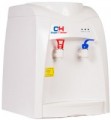Hot water tank volume
The volume of the hot water tank provided in the device.
This parameter describes the maximum amount of hot water that the cooler can produce in one run, without interruption or with minimal interruptions. When this amount is exhausted, you will have to wait until the water in the tank heats up again to a sufficient degree; the waiting time depends on the heating capacity (see below). At the same time, the volume of hot water tanks in modern devices is usually several litres, and it is extremely rare to drain this volume entirely — usually, small portions of 200-300 mL are required. Therefore, this tank plays the role of a buffer — when the user drains the next portion of water, water from a bottle or a water mains is added to the tank; such an admixture does not particularly affect the temperature in the tank, however, for an additional guarantee, the heating system immediately turns on. Thus, if the consumption does not exceed the heating capacity, the temperature of the contents remains practically unchanged.
Cooling performance
The performance of the cooling system installed in the device, in other words, is the amount of water that can be cooled per hour. In coolers, it is usually indicated for water at room temperature — about 20 °C, in models with a connection to the water mains (see "Water loading") — for 15 °C (this is the average temperature of cold water). Accordingly, when deviating from these indicators, the actual performance may be slightly more or less (however, such deviations must be very significant for this to become noticeable).
This parameter determines two main points. First of all, it characterizes the maximum flow of cold water that the device can handle and the recommended breaks between use. For example, if a user needs to collect 2 standard 200-gram cups and the cooler specifications state a cooling capacity of 2 L/h, this means that the cooler will cool 400 g (0.4 L) of water that has entered the tank, for 0,4/2 = 0.2 h, that is about 12 minutes. However, the need for such calculations arises mainly with high water consumption, which is very close to the claimed performance.
Also, knowing the cooling rate and the volume of the cold water tank (see above), you can determine how long it will take to cool the tank filled with water at room temperature. Such situations arise during the first use of the device, as well as when draining the entire volume of the reservoir. So, if in the above example, the volume of the tank is 3 litres, then 3/2 = 1.5 hours...will be spent on cooling it. However, you can use water earlier, if a slightly elevated temperature is not critical.
Heating power
It is the power consumed by the device in water heating mode. Usually, it is the operating power of the heating element.
This parameter is directly related to the heating performance (see above): a high heating rate inevitably requires appropriate power. Also, the power consumption of the device depends on this parameter. However, it is worth noting that after the end of heating, the device switches to the temperature maintenance mode and requires much less energy. In other words, the heater consumes the specified power not constantly but occasionally, as needed.
It is also worth mentioning that in models that work only for heating, this indicator also describes the maximum power consumption of the entire device. And, if there are two modes (heating and cooling), the total maximum power consumption corresponds to the sum of the powers of both modes.
Cooling power
It is the power consumed by the device in water cooling mode. In other words, this is the power required for the operation of all elements of the cooling system — a compressor or a converter with a fan (depending on the type of cooling, see above).
This parameter is directly related to the cooling performance (see above): a high cooling rate inevitably requires appropriate power. However, with the same power, compressor systems are more performant than electronic ones. Only models with coolers of the same type can be compared in terms of power.
Also note that the cooling system does not consume this power constantly, but only when necessary. So, at room temperature of the water in the "cold" tank, it turns on at full capacity, and when the desired temperature is reached, it switches to its maintenance mode, which requires much less energy.
In cooling-only models, this figure describes the maximum power consumption of the entire device. And, if there are two modes (heating and cooling), the total maximum power consumption corresponds to the sum of the powers of both modes.

